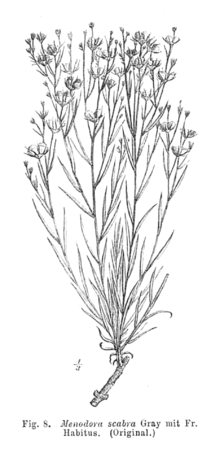Menodora scabra
Menodora scabra (formerly Menodora scoparia)[3] is broom-like shrub in the Olive Family (Oleaceae), known by the common name rough menodora or broom twinberry.[4] It is a popular desert garden plant.[4]
| Rough menodora | |
|---|---|
 | |
| illustration circa 1895[1] | |
| Scientific classification | |
| Kingdom: | Plantae |
| Clade: | Tracheophytes |
| Clade: | Angiosperms |
| Clade: | Eudicots |
| Clade: | Asterids |
| Order: | Lamiales |
| Family: | Oleaceae |
| Genus: | Menodora |
| Species: | M. scabra |
| Binomial name | |
| Menodora scabra | |
| Synonyms[2] | |
| |
Range and habit
It is native to the southwestern United States (Colorado, Arizona, Utah, New Mexico, Nevada, Texas and California) and northern Mexico (Coahuila, Durango, Nuevo León, Chihuahua, Sonora), where it grows in varied mountain, plateau, and desert habitat.[5][6][7]
Growth pattern
Menodora scabra is a small, multibranched subshrub producing several upright stems no more than 30 centimeters tall. It is coated in rough hairs and short, woolly fibers.
Leaves and stem
The leaves are oblong or oval, smooth along the edges, and alternately arranged on the branches. They are one or two centimeters long, the larger leaves located lower on the plant.
Flowers and fruit
The inflorescence is a loose cluster of yellow flowers at the tip of a stem branch. The flower corolla has 4 to 6 lobes with the stamens and stigma protruding from the short throat. The fruit is a capsule.[8][9][10]
Ethnobotanical uses
Native American Navajo people developed cold infusion of this plant to treat heartburn and facilitate labor for childbirth. A root decoction was used to treat spinal pain.[11]
References
- E. Knoblauch: Oleaceae, Salvadoraceae. In Engler, Prantl (eds.): Die natürlichen Pflanzenfamilien [...] IV. Teil. 2. Abteilung Leipzig, W. Engelmann
- Kew World Checklist of Selected Plant Families, Menodora scabra
- Mojave Desert Wildflowers, Pam MacKay, 2nd Ed., p. 237
- Mojave Desert Wildflowers, Pam Mackay, 2nd Ed. 2013, p. 237
- Biota of North America Program, Menodora scabra
- Gray, Asa. 1852. American Journal of Science, and Arts, ser. 2, 14(40): 44, Menodora scabra
- CONABIO. 2009. Catálogo taxonómico de especies de México. 1. In Capital Nat. México. CONABIO, Mexico City.
- Jepson Manual Treatment
- USDA Plants Profile
- Shreve, F. & I. L. Wiggins. 1964. Vegetation and Flora of the Sonoran Desert 2 vols. Stanford University Press, Stanford.
- Littlefield, Larry J.; Burns, Pearl M. (2015). Wildflowers of the Northern and Central Mountains of New Mexico: Sangre de Cristo, Jemez, Sandia, and Manzano. Albuquerque: University of new Mexico Press. p. 202. ISBN 9780826355478.